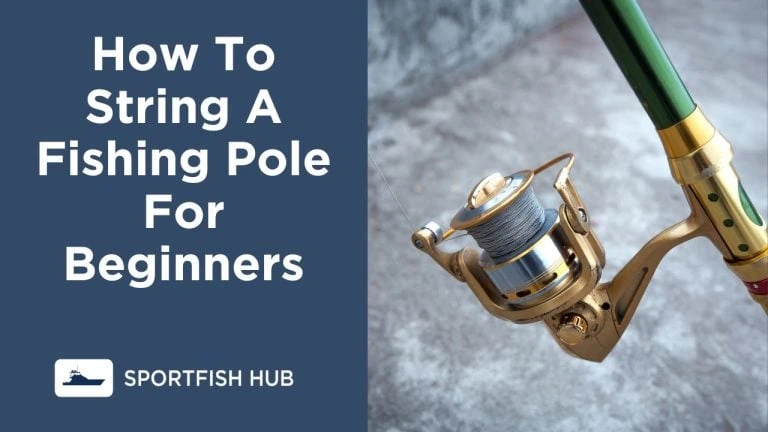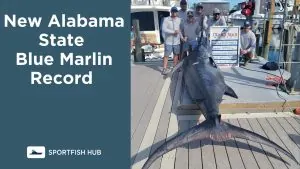Stringing a fishing pole is an essential skill every angler should learn before their next fishing trip. This straightforward guide will teach you how to properly string a fishing pole, from selecting the right line and tying secure knots to filling the reel spool evenly.
Key Takeaways To Properly String a Fishing Pole
- Choose an appropriate strength and type of fishing line for your rod and target fish
- Thread the line through the rod guides starting at the tip
- Tie the line onto the reel spool using an arbor knot
- Fill the reel by winding line evenly onto the spool
- Leave about 1/4 inch of empty spool when full
- Tie on hooks, lures or bait with clinch knots
Helpful Video To Watch:
Table of Contents
- Key Takeaways To Properly String a Fishing Pole
- Helpful Video To Watch:
- Step 1: Get Your Fishing Line Ready
- Step 2: Thread the Line Through the Fishing Rod Guides
- Step 3: Tie the Line onto the Reel Spool
- Step 4: Fill the Reel Spool with Line
- Step 5: Tie on Terminal Tackle
- Frequently Asked Questions:
- Summary
Step 1: Get Your Fishing Line Ready
- Check your rod for the recommended line strength and type. This is usually indicated by a rating like “6-12 lb test”.
- Select an appropriate pound test monofilament or braided line within that range. Lighter line for smaller fish, heavier for big fish.
- For beginners, 10 lb test monofilament works well for spinning reels and 20 lb for baitcasters.
- Match the line type to the water being fished. Monofilament for freshwater, braided for saltwater. You can also use braided line when fly fishing.
Step 2: Thread the Line Through the Fishing Rod Guides
- Start by threading the new fishing line through the smallest guide at the tip of the rod.
- Then thread through each following guide on the rod working down towards the reel.
- Make sure the line goes through each guide without tangling.
Step 3: Tie the Line onto the Reel Spool
- Open the bail arm on the reel and tie the line onto the spool using an arbor knot.
- Wrap the line around the spool twice then tie a loose overhand knot around the standing line.
- Tie another overhand knot on the tag end to lock it.
- Pull the line tight and trim the tag end close to the knot.
Step 4: Fill the Reel Spool with Line
- With the rod tip down, reel in the line while gently holding tension on the line with your fingers.
- Wind the line evenly and tightly onto the spool.
- Fill the reel spool until the line is about 1/4 inch from the outer edge of the spool.
- Cut the line free from the filler spool and tie to the reel.
Step 5: Tie on Terminal Tackle
- Tie hooks, lures, bobbers or weights to the end of the line using improved clinch knots.
- Wrap the line 5 times around itself and thread the tag end through the hook eye and main loop.
- Pull the line tight so the coils bind against the hook eye at the end of the rod. Trim excess line.
- Add a swivel if needed to prevent line twist when casting artificial lures or live bait.
And there you have it! With your fishing rod strung up properly, you’ll be ready to head out on the water and start reeling in the big ones. Follow these tips on how to string your fishing pole and take your time – it takes some practice but the payoff is worthwhile.
Frequently Asked Questions:
What fishing knot should I use to tie on lures and hooks?
The improved clinch knot works great for tying on most terminal tackle like hooks, lures and swivels. It’s easy to tie and holds secure even after fighting powerful fish.
How tight should I fill the fishing reel spool?
Fill the reel spool until the line is about 1/4 inch from the outer edge of the spool. Overfilling can cause backlashes and tangling issues. Leave a little room for the line to expand.
What happens if I put the line on the reel backwards?
This can cause the line to twist and tangle. Make sure the line spools off in the same direction that the reel retrieves line to prevent issues.
Can I use braided line on a spinning reel?
Yes, braided line works well on open face spinning reels. Make sure to tie a monofilament leader to the end though for best knot strength. Start with 10-20 lb braid.
How do I know what strength line to use?
Check your rod for the recommended line strength. Use lighter lines like 6-10 lbs for panfish and trout. Move up to 14-20 lbs or heavier for bass, pike and other large gamefish.
What if my line breaks when I have a fish on?
Try to keep tension on the line as the fish runs. If it still breaks, quickly reel in the loose line, retie your lure or bait and get back out there! Break-offs happen on big fish.
Summary
So in summary, learning how to properly string and fill your fishing reel, choosing the right line type and strength, and tying secure knots are the key steps to rigging up your rod and being set to catch fish on your next fishing trip. Follow this guide on how to string your fishing pole and you’ll be a pro in no time!












